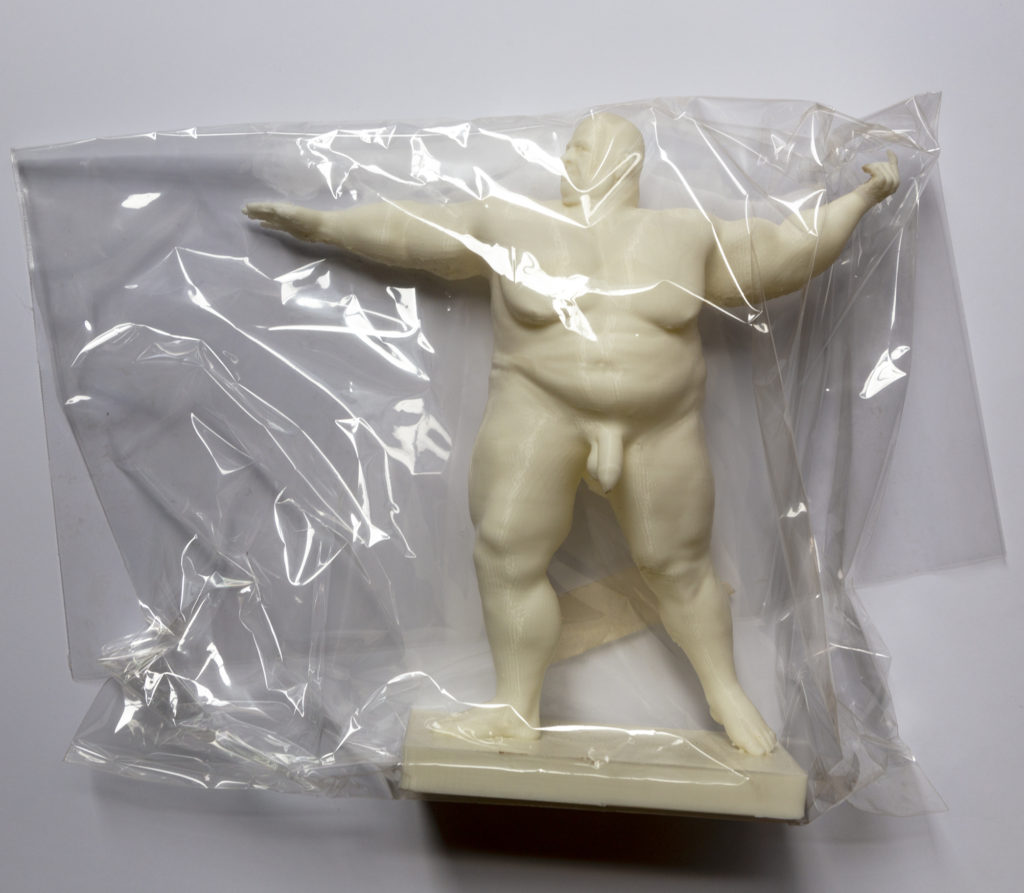On September 17th, 2017, the last day of documenta 14, I wrote a Minus Plato post called ‘Exit through the Trojan Horse’. Today’s post – one of a handful left before Minus Plato ends on May 4th, 2022 – borrows the same title as part of a collaboration with documenta 14 artist Daniel García Andújar as part of the exhibition The Sculpture Shoppe at Ithaca Mall (organized by Verity Platt and David Nasca) that will run from May 5-30, 2022. Here is the wall-text that I wrote as my part of the collaboration, along with images of the works by Andújar and an altered version of the exhibition poster (with text in the Pueblo typeface by Vier5 – the visual appearance of documenta 14 in Athens and Minus Plato).
Exit through the Trojan Horse
Daniel García Andújar + Minus Plato
The installation comprised four 3D printed sculptures from the series Liberated models. Hacking the canon (2019) 7x7x7, wrapped in plastic, and The Trojan Horse: Burning the Canon (2017), video 37:26 mins (both by Daniel García Andújar) and this wall-text (2022) (by Minus Plato).
The blog, platform, and persona Minus Plato (2012-2022) came to an end on May 4th, 2022, the day before this exhibition opened to the public. This means that the wall-text you are now reading, like all wall-texts in this exhibition and any exhibition, was written in the past according to the protocols of a technology of production, a matter of interface and coding deployed for you and your fellow visitors in your real-time experience of artworks at a particular time and place. What makes this wall-text different, however, is that it reveals how dominant operating systems, not only of the art world, but also the academic field of Classics, work.
What you are reading (well, a version that has been approved by the exhibition organizers) was first published on the Minus Plato blog on the same day it was written (Friday April 29th). Why does this matter? And what has this got to do with the contemporary artistic versions and visions of Classical sculpture that surround you here and now? Like the work this wall-text was written to accompany by artist Daniel García Andújar, born in 1966 in Almoradí, Spain during the last phase of the Franco dictatorship, Minus Plato’s interventions in public space stem from a critical use of digital media and communication strategies.
Over its ten-year life, the blog, platform and persona have shifted from engaging with how contemporary artists are inspired and delighted by ancient Mediterranean cultures represented by the idealized white bodies of ancient Greek and Roman sculpture to a refusal to perpetuate entrenched canons of supremacy (white, Western, patriarchal, colonial) without settling for good intentioned post-classicisms and other moves to innocence.
The pivotal moment in this shift was the 2017 exhibition documenta 14, held between Athens, Greece and Kassel, Germany, at which Andújar first presented versions of the works you see before you that hacked into the Classical Greek and German Phil-Hellenic canons and idealized body-forms, proceeding to offer tools to break and burn them down from within. Just watch the video to see what this looks like.
Beyond the wall-text, another protocol of the art world is the museum gift shop, and its incorporation of capitalist logic of extraction into the aesthetic experience. Since you are standing in a mall looking at the works of contemporary artists, maybe things have shifted. Or perhaps the currency of classical sculpture in how academic classicists coopt artistic practices to bolster their waning significance has finally reached its peak value. Either way, where do we go from here? One way is to follow Andújar and other artists in this exhibition in the subversion of hacking the classical canon from within. Another is to look past the limited perspective you are being sold here to worlds that offer different models of value and empowerment. To do this, you would first need to acknowledge that you are an uninvited guest on the land of the Gayogo̱hó꞉nǫ’ (the Cayuga Nation), members of the Haudenosaunee Confederacy, an alliance of six sovereign Nations and that the dispossession of their land (from this mall to Cornell University) was and still is made possible by those who continue to be inspired and delighted by ancient Greek and Roman sculpture and their endless copies.

